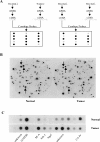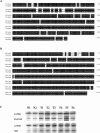Differential gene expression in chemically induced mouse lung adenomas
- PMID: 12659669
- PMCID: PMC1502122
- DOI: 10.1016/s1476-5586(03)80016-7
Differential gene expression in chemically induced mouse lung adenomas
Abstract
Because of similarities in histopathology and tumor progression stages between mouse and human lung adenocarcinomas, the mouse lung tumor model with lung adenomas as the endpoint has been used extensively to evaluate the efficacy of putative lung cancer chemopreventive agents. In this study, a competitive cDNA library screening (CCLS) was employed to determine changes in the expression of mRNA in chemically induced lung adenomas compared with paired normal lung tissues. A total of 2555 clones having altered expression in tumors were observed following competitive hybridization between normal lung and lung adenomas after primary screening of over 160,000 clones from a mouse lung cDNA library. Among the 755 clones confirmed by dot blot hybridization, 240 clones were underexpressed, whereas 515 clones were overexpressed in tumors. Sixty-five clones with the most frequently altered expression in six individual tumors were confirmed by semiquantitative RT-PCR. When examining the 58 known genes, 39 clones had increased expression and 19 had decreased expression, whereas the 7 novel genes showed overexpression. A high percentage (>60%) of overexpressed or underexpressed genes was observed in at least two or three of the lesions. Reproducibly overexpressed genes included ERK-1, JAK-1, surfactant proteins A, B, and C, NFAT1, alpha-1 protease inhibitor, helix-loop-helix ubiquitous kinase (CHUK), alpha-adaptin, alpha-1 PI2, thioether S-methyltransferase, and CYP2C40. Reproducibly underexpressed genes included paroxanase, ALDH II, CC10, von Ebner salivary gland protein, and alpha- and beta-globin. In addition, CCLS identified several novel genes or genes not previously associated with lung carcinogenesis, including a hypothetical protein (FLJ11240) and a guanine nucleotide exchange factor homologue. This study shows the efficacy of this methodology for identifying genes with altered expression. These genes may prove to be helpful in our understanding of the genetic basis of lung carcinogenesis and in developing biomarkers for lung cancer chemoprevention studies in mice.
Figures




Similar articles
-
Altered gene expression profile in chemically induced rat mammary adenocarcinomas and its modulation by an aromatase inhibitor.Oncogene. 2001 Nov 22;20(53):7710-21. doi: 10.1038/sj.onc.1204941. Oncogene. 2001. PMID: 11753649
-
Detection of differentially expressed genes in mouse lung adenocarcinomas.Exp Lung Res. 2001 Apr-May;27(3):217-29. Exp Lung Res. 2001. PMID: 11293325
-
Differential gene expression in human lung adenocarcinomas and squamous cell carcinomas.Clin Cancer Res. 2002 Apr;8(4):1127-38. Clin Cancer Res. 2002. PMID: 11948124
-
Profiling of linker histone variants in ovarian cancer.Front Biosci (Landmark Ed). 2012 Jan 1;17(2):396-406. doi: 10.2741/3934. Front Biosci (Landmark Ed). 2012. PMID: 22201751 Free PMC article. Review.
-
Preclinical mouse models for cancer chemoprevention studies.Ann N Y Acad Sci. 1999;889:14-9. doi: 10.1111/j.1749-6632.1999.tb08719.x. Ann N Y Acad Sci. 1999. PMID: 10668478 Review.
Cited by
-
Identification and characterization of RBEL1 subfamily of GTPases in the Ras superfamily involved in cell growth regulation.J Biol Chem. 2009 Jul 3;284(27):18129-42. doi: 10.1074/jbc.M109.009597. Epub 2009 May 11. J Biol Chem. 2009. PMID: 19433581 Free PMC article.
-
A review of the past, present, and future directions of neoplasia.Neoplasia. 2005 Dec;7(12):1039-46. doi: 10.1593/neo.05793. Neoplasia. 2005. PMID: 16354585 Free PMC article. Review. No abstract available.
-
Altered tumor biology and tumorigenesis in irradiated and chemical carcinogen-treated single and combined connexin32/p27Kip1-deficient mice.Cell Commun Adhes. 2005 Jul-Dec;12(5-6):293-305. doi: 10.1080/15419060500514168. Cell Commun Adhes. 2005. PMID: 16531324 Free PMC article.
References
-
- Beckett WS. Epidemiology and etiology of lung cancer. Clin Chest Med. 1993;14:1–15. - PubMed
-
- Fielding JE. Smoking: health effects and control (1) N Engl J Med. 1985;313:491–498. - PubMed
-
- Herzog CR, Lubet RA, You M. Genetic alterations in mouse lung tumors: implications for cancer chemoprevention. J Cell Biochem Suppl. 1997;28–29:49–63. - PubMed
-
- Witschi H, Espiritu I, Maronpot RR, Pinkerton KE, Jones AD. The carcinogenic potential of the gas phase of environmental tobacco smoke. Carcinogenesis. 1997;18:2035–2042. - PubMed
-
- Witschi H, Espiritu I, Peake JL, Wu K, Maronpot RR, Pinkerton KE. The carcinogenicity of environmental tobacco smoke. Carcinogenesis. 1997;18:575–586. - PubMed
Publication types
MeSH terms
Substances
Grants and funding
LinkOut - more resources
Full Text Sources
Other Literature Sources
Medical
Research Materials
Miscellaneous
